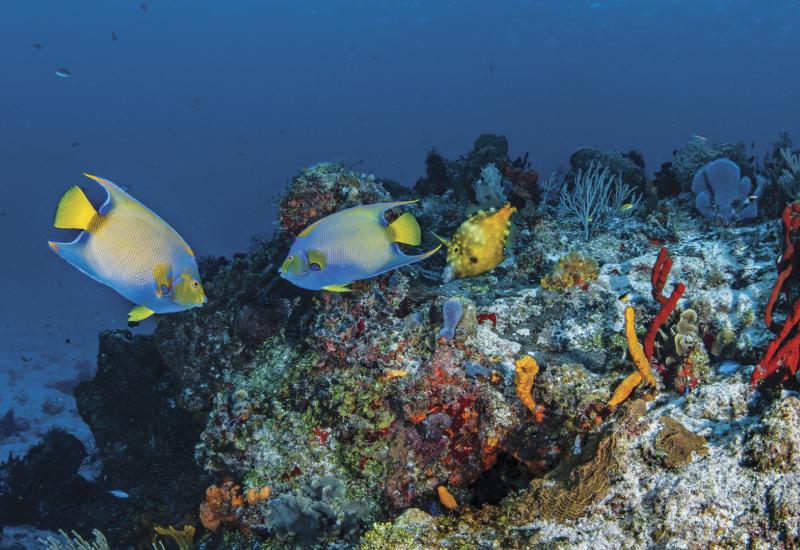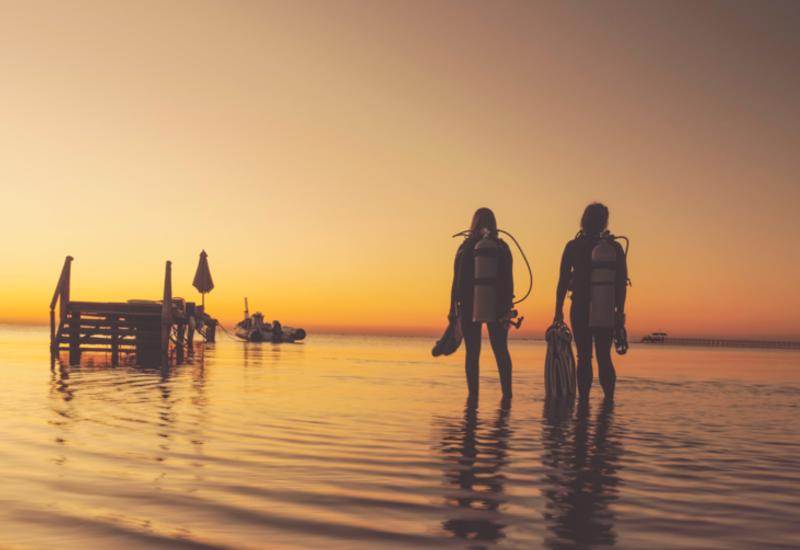Siren Story

On this day you could be floating over lush soft coral, or swimming straight into a school of jacks. Tomorrow, it could be a fast drift past giant elephant-ear corals and clouds of bluetooth triggerfish, or mucking about the wrecks of two cars that have become home to a small battalion of ghost pipefish. The itinerary might be a little flexible, but on the S/Y Philippine Siren’s Southern Visayas trip you get a little bit of everything, with a lot of the eye-popping color and fish life this Southeast Asia archipelago is known for.
Itinerary (Five-Day Sampler)
Day One: Arrive in Cebu, check into the boat after lunch and sail off, enjoying dinner on board.
Day Two: Cabilao. Easy morning checkout dive in Cambaquiz (1), featuring walls and sandy patches. Groupers, batfish, gobies, scorpionfish, porcelain crabs and garden eels are easily spotted, along with nudibranchs in a riot of colors. Paradise is a good place to find a pygmy seahorse, along with ghost pipefish. If you don’t find a pygmy, then it’s almost guaranteed on the next dive: Lighthouse. Train your torch on squid, cuttlefish and curious shrimpfish on a night dive in Crab City in Panganang.
Day Three: Cabilao to Balicasag. Start with a beautifully lit, current-free early morning dive at Cabilao’s South Point (2), where whitetips frequent a deep cave in an area of stunning overhangs. Balicasag’s Black Forest (3) is named for the very dark green hard coral growth and is home to turtles, snappers, trevally and moray eels. Night dive here or in Siquijor’s Coco Grove (4).
Day Four: Siquijor to Dauin. Begin the day with a 60-foot plunge at Siquijor’s own Lighthouse (5), a site full of sandy channels. Check out lobsters, sea snakes and mantis shrimps. More sea snakes can be spotted at Paliton Wall, where a turtle could also be waiting in hiding amid gorgeous soft corals. The Cars at Dauin (6) are a muck diver’s delight, with frogfish and robust and ornate ghost pipefish, seahorses, devil fish and loads of nudibranchs among the residents. Enjoy a sunset dive at Masaplod North (7), where the sea grass conceals a wealth of critters.
Day Five: Welcome to Apo Island (8), and get an invigorating start with a fast drift dive through Cogon, where jacks, titan and bluetooth triggerfish, and turtles await you after your ride. Apo’s Rock Point East is another stop for lush coral growth as far as the eye can see. Baluarte is a pretty landscape of coral bommies that house moray eels and scorpionfish, while little bubbles rising from spring vents on the seafloor make for a strange sight. For a sunset dive, Apo Island’s Chapel (9) is a good place to find mandarinfish. * Note: For the 10-day itinerary, the boat stays longer in each area.
The middle islands among the three major groupings that make up the Philippines, the Visayas region is known for great food and a relaxed, laid-back vibe. It’s also the place to go for some of the most colorful diving in the country. Many dive sites were damaged in the past by typhoons and destructive fishing, but have recovered quite remarkably thanks to better local enforcement and a growing awareness of conservation. Apo Island — what might be the Philippines’ most successful marine sanctuary, and the field laboratory of the renowned marine biology institute of nearby Silliman University in Dumaguete — is a highlight of the trip. The Philippine Siren offers a 10-day cruise through the southern islands, beginning and ending on the island of Mactan in the city of Cebu, a southern hub that offers both urban comforts and quiet beaches. (An abbreviated five-day trip ends in Dumaguete, farther to the south.) The underwater terrain varies along the way. Divers explore slopes, walls festooned with fan corals, overhangs, channels, sandy bottom stretches and mazes of coral bommies with hidden surprises. Though the boat departs from Cebu, the diving kicks off in Cabilao, just a few hours away. At Lighthouse, bubble corals shelter fuzzy orangutan crabs, and you’re almost guaranteed to find a pygmy seahorse expertly hiding in a grouping of corals at 80 feet. At the mushroom-shaped Balicasag Island in Bohol, black corals grow in profusion, while snappers, groupers, barracuda and turtles like to hang out in the shifting currents. Finally in Dumaguete, stops at Apo Island and nearby Dauin offer the quaint juxtaposition of ripping currents and delightful muck (though not on the same dive, thankfully). For the remaining 20 hours or so of each day — that’s between your four dives — it’s difficult not to relax on the 131-feet-long Philippine Siren, operated by Worldwide Dive and Sail. Built by hand in the traditional Indonesian pinisi style from ironwood and teak, the Philippine Siren is run by a top-notch crew who attends to your every need. There are drinks and warmed towels after night dives, and the boys on the dive deck soon figure out what you like to wear — is it the 3 mm or the Polartec? — for different dives, laying your gear out before each plunge and practically peeling them off you to rinse afterward. There are eight cabins for 16 people, a beautiful sun deck, a comfortable open dining area where buffet meals are laid out by the chef, and a lounge with a huge TV. Hankering for alone time? There’s a computer in every room so you can watch a movie in peace, and housekeepers double as trained masseuses — a fabulous way to end a great day of diving.
Need to Know
Getting There -- Cebu (CEB) receives direct flights from Asian cities like Hong Kong (HKG) and Singapore (SIN). Or, if you’re traveling internally, Cebu Pacific ( www.cebupacificair.com ) and Philippine Airlines ( www.philippineairlines.com ) offer several daily flights from Manila (MNL) to Cebu. Worldwide Dive and Sail can arrange airport transfers, but the airport is a mere five-minute cab ride from the Cebu Yacht Club, where the boat is docked.
When to Go -- The Visayas are accessible year-round, but the Philippine Siren doesn’t do trips during the Philippines’ rainy season, from July through September.
Dive Conditions -- Water temperatures range from 79 degrees F during the winter months to a toasty 88 degrees F March through early June. Visibility varies according to the weather, as well, from a manageable 50 feet to upwards of 100 feet and beyond.
Price Tag -- The 10-day Southern Visayas itinerary costs about $3,288 per person. The Philippine Siren also does 10-day trips to Southern Leyte and Bohol, and from Boracay to Coron via Apo Reef for the same price.
More Info -- Philippine Siren, www.worldwidediveandsail.com Insider’s Tip The Philippine Siren will offer five underwater photography workshops on select trips in 2010, starting in July with back-to-back five-day courses from Singaporean wunderkind Aaron Wong. Cebu is a great city to come back to after several days at sea. Savor the famously sweet mangos or feast on seafood, including kilawin, or raw fish marinated in vinegar and chilies. The local crafts are excellent and the nightlife is jumping.

If the Boat Fits...
The Philippine Siren has a comprehensive Southern Visayas route as well as an extended and well-rounded Tubbataha itinerary. For those who want to go straight to this mecca of Philippine diving, other boats make direct trips to Tubbataha during the summer months of March through June — but book early to have a choice of vessel.
The Expedition fleet Four live-aboard boats from this company ( www.expeditionfleet.com ) make the annual pilgrimage to Tubbataha: the nine-cabin Borneo Explorer, the 12-cabin Pacific Explorer II, the 14-cabin Oceanic Explorer and the 10-cabin Stella Maris. They vary in price range, depending on size and luxury level, for a five-night trip — minus the $78 Tubbataha Conservation Fee.
Hans Christian Andersen Originally built in Holland as a schooner and refitted four years ago as a dive cruise ship, this large vessel with room for 46 passengers now operates in the Philippines under Danish management (thus the boat’s moniker, renamed after the famous Danish writer of fairy tales). It accommodates 18 to 24 divers and will run World Heritage tours to Tubbataha and other sites in 2011, in collaboration with the World Wide Fund for Nature. The boat also does trips to some southern islands, including Leyte, as well as Apo Reef and Coron. Check out www.hcacruise.com.










